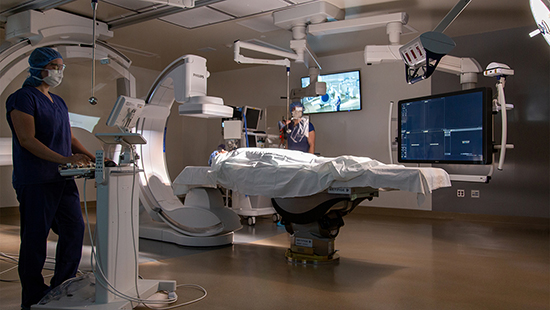|
Subscribe / Renew |
|
|
Contact Us |
|
| ► Subscribe to our Free Weekly Newsletter | |
| home | Welcome, sign in or click here to subscribe. | login |
Construction
| |
 |
February 5, 2021
Best in State: Gold award — Complexity
Notkin, a P2S company

Project: Hybrid biplane operating room
Client: Harborview Medical Center/Aldrich and Associates
Harborview Medical Center is a publicly owned critical-access hospital. It is the only Level 1 trauma center in the state and has served the public for over a century. The installation of a new biplane neurosurgery suite is an example of maintaining performance and excellent care within aging infrastructure constraints.
Planning a construction project within a functioning surgical suite presents numerous unique and complex challenges. In addition to the normal design and engineering for new construction, there are challenges with accessibility, infection control and maintaining functional utilities. Notkin, a P2S company, participated in many planning exercises not only with design partners but with the hospital project managers, surgical staff, facilities staff, construction crew and equipment vendors. This full-team approach to information gathering enabled a thorough perspective of the project constraints and led to a successful outcome.
The need to maintain live utilities to adjacent surgical suites during construction required a highly detailed level of planning with installers and the facilities crew in the field to identify the actual points of demolition and new connections for a wide variety of necessary piping systems.
This project was executed within a complex infrastructure zone. The ceiling area in this type of surgical suite is exceedingly congested with multiple mechanical systems, including hygienic air delivery, water, equipment booms, lighting, medical gases, power, A/V and communications cabling.
The team’s meticulous planning efforts also increased the overall efficiency of the mechanical systems. Taking into account the high rate of air exchange required when surgery is in progress, new operating room controls were installed with automated modes for when the space is occupied versus vacant. A local display allows the surgical staff to monitor the room mode and produces an alarm if the room is occupied but not in the correct air exchange mode. These features provide energy efficiency by allowing the air delivery systems to ramp down when necessary but also maintain safety and hygiene as a high priority.
Other Stories:
- National finalist: Platinum award — Structural Systems
Magnusson Klemencic Associates - National finalist: Gold award — Water Resources
Parsons and GeoEngineers - Best in State: Gold award — Future Value to the Engineering Profession
Century West Engineering - Inclusion Award — Midsize firm
- Engineer of the Year
- Inclusion Award — Midsize firm
- National finalist: Gold award — Transportation
HDR - Best in State: Gold award — Social, Economic and Sustainable Design
Parametrix - Best in State: Gold award — Unique or Innovative Applications
Parr Excellence - National finalist: Gold award — Structural Systems
KPFF Consulting Engineers - Best in State: Gold award — Successful Fulfillment of Client/Owner Needs
COWI North America and HNTB - National finalist: Gold award — Special Projects
HDR


